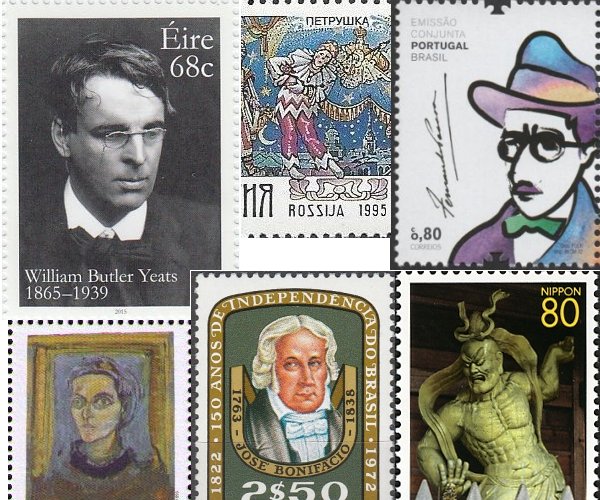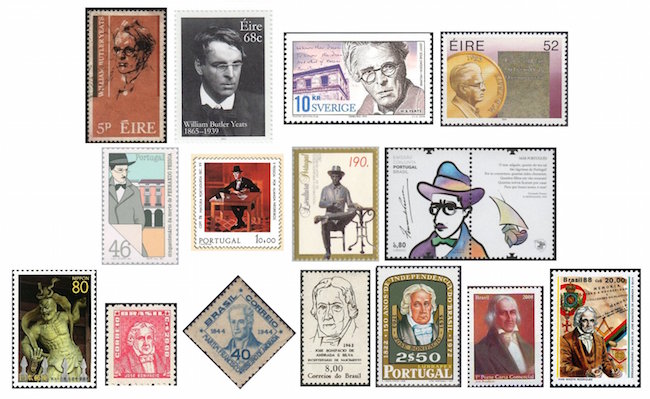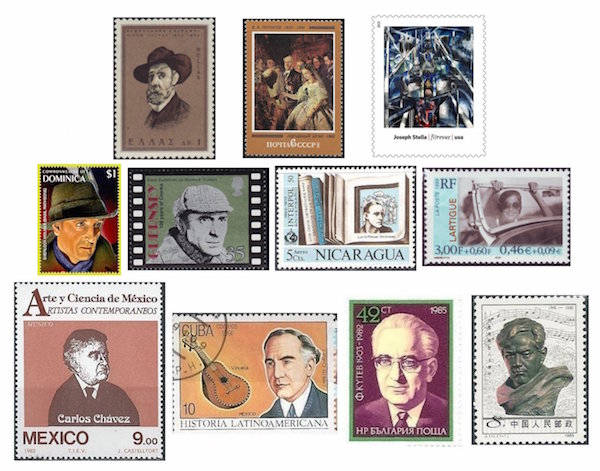The Arts on the Stamps of the World — June 13
An Arts Fuse regular feature: the arts on stamps of the world.

By Doug Briscoe
As with yesterday’s Egon Schiele, today we have among our many artists one who claims top honors: William Butler Yeats (13 June 1865 – 28 January 1939).
Yeats’ poetry seems not to have traveled particularly well beyond English-speaking composers, but of them there are a great many: songs and choral settings abound. “Down by the Salley Gardens” alone has been set by Britten, Ivor Gurney, Gerald Finzi, John Ireland, Rebecca Clarke, and Samuel Adler. One of the loveliest and most memorable Yeats compositions is surely Peter Warlock’s 1922 cycle of four Yeats poems, “The Curlew”. Emily Ezust’s wonderful and exhaustive LiederNet Archive lists works by British and Irish composers Frank Bridge, Hamilton Harty, Ernest John Moeran, Lennox Berkeley, Havergal Brian, the late John Tavener, who produced two Yeats cycles, and Michael Tippett, among others. Another English composer, Arnold Bax, despite having been profoundly affected by Yeats (the poet inspired the composer’s lifelong love of Ireland), never set any of his words. On being asked why, Bax responded, “What, I? I should never dare!” He did write a symphonic poem, “Cathleen ni Houlihan” (1905), inspired by Yeats’s play. Many Americans have dared to answer the Yeatsian call: Samuel Barber (the second of his Four Songs, Op. 13), Arthur Foote, John Alden Carpenter, Charles Martin Loeffler, Lee Hoiby, Arthur Berger, Ned Rorem, Jack Beeson, Paul Moravec, Yehudi Wyner… The Commonwealth is represented by Canadian Healey Willan and Australians Malcolm Williamson and Colin Brumby and more. On a grander scale, operas based on plays by Yeats include Werner Egk’s Irische Legende (one of the beyond-the-English-language-pale exceptions, 1955, rev. 1969–70), Purgatory by Gordon Crosse (1966), Thomas Pasatieri’s Calvary (1971), and John Harbison’s Full Moon in March (1979). Elgar wrote incidental music to Grania and Diarmid (co-authored by Yeats and George Moore) in 1901, and George Antheil, of all people, set excerpts from Fighting the Waves in his incidental music for that 1929 play.

Standing nearly as tall in the minds of many—and not only his fellow Portuguese—is Fernando Pessoa (June 13, 1888 – November 30, 1935), one of the foremost wordsmiths of his native tongue. On the death of his father and subsequent remarriage of his mother, Fernando was taken to Durban in South Africa, an event he considered crucial in his development because of the English education he received there. No clearer indication of his love for his newly acquired language can be found than his Queen Victoria Memorial Prize, which he earned at 15 for the best paper above all his native English-speaking classmates. He continued writing stories in English before returning to Lisbon at 17. An introvert and loner, he founded a number of journals, adding to his output with poems and translations of Hawthorne (The Scarlet Letter), Poe, Whitman, and Annie Besant. (He was keenly interested in theosophy and astrology.) Some of the poems he wrote were composed in English—indeed, he published only one volume of poems in Portuguese. Yet his output was prolific, and he used some eighty different pen names—he called them heteronyms—during his career. All the stamps are from Portugal, the third one showing the statue of Pessoa by Lagoa Henriques that sits, literally, outside a Lisbon café that had been frequented by the poet.
For our next subject we must turn back the clock some eight centuries. Japanese sculptor Tankei was born about 1173 and died on this date 1256. His father Unkei was also a master sculptor. Tankei did a great deal of work for Buddhist temples, including Sanjūsangen-dō in Kyoto, which contains his Senju Kannon and a thousand lifesize statues, of which the one shown on the stamp was formerly attributed to Tankei. (The temple was destroyed by fire in 1249, but 124 of the statues were rescued, and the others were recreated later in the century).
The Brazilian polymath José Bonifácio de Andrada (13 June 1763 – 6 April 1838) was a statesman, a champion of independence, an abolitionist, a naturalist and professor of geology who discovered four new minerals, a linguist familiar with twelve languages and fluent in four, and…a poet. His Poesias Avulsas (1825) were published while he was in exile in France. The stamps, of course, salute him more for his accomplishments in the sociopolitical sphere than for his literary work, and that’s why there are so many of them.
Our next three consecutive subjects chronologically were all painters, two of whom have unknown birth dates but died on a June 13. Like Tankei and yesterday’s Bertram Mackennal, Nikiforos Lytras, who died on this date in 1904, was the son of a sculptor, but unlike them, Lytras became a painter. Born on the Greek island of Tinos in 1832, he became an exponent of the “Munich School” of Greek artists along with Nikolaos Gyzis, whom he met while studying there in 1865. Lytras himself taught at the Athens School of Fine Arts for nearly four decades. Along with his representations of Greek history and mythology (e.g., Antigone in front of the dead Polynices of 1865), he later turned to genre paintings like Carols (1872) and executed portraits of King Otto and Queen Amalia.
The Russian Vassili Pukirev (PU-keer-yev; 1832 – 13 June [O.S. 1 June] 1890), born a peasant in Tula and apprenticed to an icon painter in Mogilev. Good fortune enabled him to study at the Moscow School of Painting from 1847 to 1858, where he ended up teaching. Among his works, besides icons, are book illustrations for Gogol and Turgenev, and his most celebrated picture is The Unequal Marriage, as seen on the stamp. Pukirev put himself into the picture at far right.

American Futurist Joseph Stella (Giuseppe Michele Stella, 13 June 1877 – November 5, 1946) was born in the south of Italy and came to the United States to study medicine, soon abandoning it for art. Longing for the sunshine of his homeland, he returned to Europe just in time to be caught up in the wave of Modernism that was to infuse his subsequent work. His timing seems to have been unerring, for he went back to New York in 1913, the year of the famous Armory Show. One of his important pieces from this time was Battle of Lights, Coney Island (1913–14). Moved by industrialism and mechanization, as well as by the human castoffs they created, Stella grew fascinated with the Brooklyn Bridge, which he painted a number of times. The most famous example, the 1919-20 Brooklyn Bridge, is seen on the stamp from a recent US sheet of modern art. Another example, Old Brooklyn Bridge (1941), can be seen at the MFA. (In case you missed it, yesterday was the birthday of John A. Roebling.) In view of Richard Strauss’ birthday a couple of days ago, I might mention Stella’s 1913-14 oil Der Rosenkavalier, painted just a decade or so after the première of Strauss’s opera.
Sherlock Holmes and Lord Peter Wimsey find common ground on this June 13th, which happens to be the birthday of both Basil Rathbone (1892 – 21 July 1967) and Dorothy Sayers (1893 – 17 December 1957). Dorothy Sayers, who regarded her translation of Dante as her finest work, has no stamp of her own but is indirectly honored with a Wimsey stamp that comes from a Nicaraguan set devoted to fictional crime solvers. I must grouse about the Guernsey Rathbone stamp, which IMHO doesn’t look much like him, even though the likeness appears to have been taken from a photograph. Rathbone usually played villains when he wasn’t playing Holmes.
Speaking of photographs, French artist Jacques Henri Lartigue (June 13, 1894 – September 12, 1986) worked in that discipline as well as in painting. He was particularly drawn to the subjects of automobile races (see the stamp), airplanes, and fashion models (see the stamp). He achieved international fame when Life magazine did a spread of his photos in 1963.
To paraphrase myself, our next three consecutive subjects chronologically were all composers. One of the finest Mexican composers was Carlos Chávez (1899 – 2 August 1978), founder of the Mexico Symphony Orchestra. Like the Cuban Amadeo Roldán (see yesterday’s entry for his stamp), Chávez often incorporated indigenous musical elements into his work; one of his best known pieces is the second of his six symphonies, the Sinfonía india, which calls for native Yaqui percussion instruments.
Bulgarian composer Filip Kutev (1903 – 27 November, 1982) and his wife founded the State Ensemble for Folk Song and Dance, a choir also known as the Filip Kutev Ensemble. Remember the Grammy Award-winning album Le Mystère des Voix Bulgares (Vol. II, 1989)? The Filip Kutev Ensemble was one of four choirs to appear on that album. Besides his work in folk music, he wrote orchestral works, chamber music, and film scores.
Wikipedia calls Xian Xinghai (1905 – October 30, 1945) “one of the earliest generation of Chinese composers influenced by western classical music…Although he composed in all the major musical forms (two symphonies, a violin concerto, four large scale choral works, nearly 300 songs and an opera), he is best known for his Yellow River Cantata” (which was later adapted as the Yellow River Concerto). His life was not without its share of adventure. He went to the USSR in 1940 to write a score for a documentary film. When Germany invaded the Soviet Union in 1941, he tried to return to China, but was stranded for some time in Kazakhstan, where he wrote a number of pieces. Unfortunately, however, he developed pulmonary tuberculosis as a result of overwork and malnutrition and died at the age of 40.

Back to Portugal we go, and back to painters, as we salute Maria Helena Vieira da Silva (13 June 1908 – 6 March 1992). Like Pessoa, she was born in Lisbon. A serious art student from childhood, she later took lessons with Fernand Léger, Antoine Bourdelle, and others. For most of her life—1929 on—she lived in Paris and became a French citizen in 1956. Her Wikipedia article tells us, “her characteristic works…were heavily impastoed, and overlaid with a complex arrangement of small rectangles…Her paintings often resemble mazes, cities seen in profile or from high above or even library shelves in what seems to be an allegory to a never-ending search for Knowledge or the Absolute.” Typical of her style is the abstract seen on the French stamp of 1993, next to the Portuguese stamp of her 1942 Self-portrait. Vieira da Silva also worked in tapestries, ceramics, and stained glass.
Again Pessoa comes to mind when we consider that Hector de Saint-Denys Garneau (June 13, 1912 – October 24, 1943), at age thirteen, won first prize in a Quebec essay competition. Two years later he won an award for one of his poems. He studied painting in Montreal and won awards for that, too. The one book of poetry he published during his lifetime was so intensely personal that he is said to have bought up all 1,000 copies and never repeated the experiment. At sixteen he had contracted rheumatic fever, which weakened his heart and was ultimately responsible for his death from cardiac arrest at age 31.
A formative experience in the young life of Paraguayan writer Augusto Roa Bastos (June 13, 1917 – April 26, 2005) was his disillusionment as a wide-eyed teenager who went off to the Chaco War of 1932-35 seeing it as a rite of passage and came back, shaken by the destruction and the horror, a confirmed pacifist. Yet war seemed to pursue him. He was awarded a fellowship to study journalism in Great Britain in, of all years, 1944; he was a war correspondent in France and Africa and returned home just in time for the Paraguayan Civil War. From that conflict he was compelled for political reasons to flee to Argentina. There he remained until forced into exile again in 1976, when he relocated to France. He achieved international recognition with his first novel Hijo de hombre (Son of Man, 1960). The work seen as his other masterpiece, Yo el Supremo (I, the Supreme), followed in 1974. After the ouster of Alfredo Stroessner Roa Bastos was finally able to return to Paraguay. In 1989 he was awarded Spain’s prestigious Premio Miguel de Cervantes. He left four other novels, many stories, plays for both stage and screen, and poetry. I should mention that a strong influence in his work was the language and customs of the indigenous Guaraní people (he regularly used Guaraní words in his writing).
I’ll come right out and boldly declare that I have no use whatsoever for the kind of “environmental art” perpetrated by Christo Vladimirov Javacheff and his wife Jeanne-Claude (who were born on the same day, June 13, 1935—she died on November 18, 2009). The Austrian stamp of 2009 hails—or at least goes out of its way to acknowledge—Christo and Jeanne-Claude’s Wrapped Flak Tower of the same year. I can’t easily find out whether this project for Vienna ever really happened or was merely proposed—the Internet keeps mum on the subject—a conspiracy of silence?—and I don’t care enough about it to dig deeper. These things, even though I gather the materials are recycled, strike me a colossal waste, to which may be added the little time I spent researching and writing about it.
English actor Malcolm McDowell (born Malcolm John Taylor; 13 June 1943) will no doubt be best remembered by future film lovers as Alex in Stanley Kubrick’s 1971 film A Clockwork Orange. McDowell gets a stamp, however, for his appearance as the villain in Star Trek Generations (1994).
The second of Stravinsky’s three great ballets, Petrushka, had its première on this date 106 years ago (1911). Diaghilev’s Ballets Russes performed it at the Théâtre du Châtelet in Paris.
Science is usually not within our purview here on The Arts on the Stamps of the World, but it can’t be denied that many scientific accomplishments have exalted the human spirit in ways akin to the greatest art, and one such achievement, the voyage of Pioneer 10, has an anniversary today. It seems to me one of the most salient landmarks in human history: the first time a human-constructed object left the confines of the planetary orbits of our solar system. Launched in 1972, Pioneer 10 bypassed the orbit of Neptune (which at the time was outside the orbit of then-planet Pluto) on June 13, 1983. When the first Pioneer 10 stamp was issued in 1975, the craft had already bypassed Jupiter and was en route to the orbit of Saturn, which it traversed before the issuance of the Mongolian stamp of 1977. By the time the 1999 stamp came out, Pioneer’s successor Voyager 1, though traveling on a different trajectory, had exceeded Pioneer’s distance from the sun. Voyager 2 is expected to do so in 2019. Earth was still receiving signals from Pioneer as late as January 2003, but now she’s on her own.
A graduate of the University of Massachusetts with a B.A. in English, Doug Briscoe worked in Boston classical music radio, at WCRB, WGBH, and WBUR, for about 25 years, beginning in 1977. He has the curious distinction of having succeeded Robert J. Lurtsema twice, first as host of WGBH’s weekday morning classical music program in 1993, then as host of the weekend program when Robert J.’s health failed in 2000. Doug also wrote liner notes for several of the late Gunther Schuller’s GM Recordings releases as well as program notes for the Boston Classical Orchestra. For the past few years he’s been posting a Facebook “blog” of classical music on stamps of the world, which has now been expanded to encompass all the arts for The Arts Fuse.
